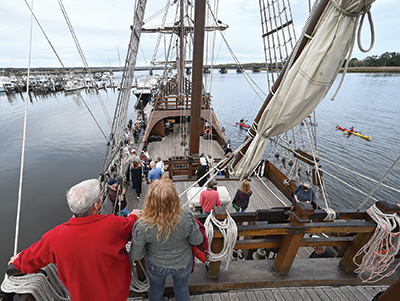History
Stories of Spanish exploration, past and present, raise hopes for the future

The replica of a 16th century Spanish ship towered over the crowds that lined the dock at Georgetown Landing Marina waiting to go on board for a tour. Many came away in awe of the men who sailed the original Trinidad across the Pacific in 1519. The ship was so small.
A similar ship, known as a “nao,” is thought to have wrecked off the coast of Georgetown County in 1526 as part of a Spanish expedition to colonize North America. Archaeologists have searched for the wreck for over 20 years across an area of 18 square miles around Winyah Bay and the ocean off the Santee Delta.
The Trinidad, which was built along the traditional lines, would leave a footprint of 3,000 to 4,000 square feet. The search area for the shipwreck covers over 500 million square feet.
And that doesn’t account for changes in the coastline over the last 500 years.
“In some parts, it’s about 2 miles out from what would have been ocean floor,” said Jim Spirek, the state underwater archaeologist at the S.C. Institute for Archaeology and Anthropology. “This is not the way it would have looked when de Allyón came.”
He was referring to Lucas Vázquez de Allyón, who led the expedition of six ships and over 600 people to found a colony near what earlier explorers had labeled the River Jordan. That is thought to have been Winyah Bay or the Santee River. Allyón’s flagship that was carrying a large share of the supplies foundered at the mouth of the river in a storm in August 1526. The expedition spent about six weeks trying to start a colony before returning to the Caribbean. Only about 150 survived. Allyón was not among them.
While the Trinidad was drawing people to the dock, Spirek was across Winyah Bay at Hobcaw Barony, speaking about his work to an audience of about 50 people. The event was part of the annual meeting of the state Archaeological Research Trust, which provides grants to projects such as the search for the Spanish shipwreck.
“The amount of time Jim Spirek is going to stay here depends on how much money we raise,” said Walter Wilkinson, who was elected to chair the trust’s board. “It would be neat if we had a sponsor.”
The trust has about $50,000 a year to award, and it tries to spread that around the state. It thinks of the grants as “seed money,” said Wilkinson, who has served on the trust board for almost 20 years. He also chairs the grants committee.
In Beaufort and Florence, archaeological projects have received support from local governments as well as the trust, Wilkinson noted.
The search for Allyón’s flagship has a key supporter in state Sen. Stephen Goldfinch. He obtained a $250,000 earmark in the state budget in 2021 to fund Spirek’s work, which is focusing on the entrance to the Santee River.
To cover the area where the historic ocean is now covered by marsh, the archaeologists began this year searching with an industrial-grade drone equipped with a magnetometer to detect the presence of metal beneath the surface. The ocean survey uses a magnetometer towed behind a boat and sonar.
The drone work got off to a slow start as the team got used to the new technology. They also did some additional ocean surveying in the fall, Spirek said.
So far, there have been no actual finds, but “that’s just the nature of the game,” he said.
The survey data will be used to identify sites for closer inspection.
“It really takes us going down there and diving to see what it is,” Spirek said. “You have to bring your eyes and hands down below to see what’s actually there.”
The project will seek an extension to the use of the state funds.
“I do think the investment is worth continuing. Of course, at some point in time you expect to see results,” Goldfinch said by phone this week from Fort Stewart, Ga., where he is completing duty with the Army Reserve. “I’m not discouraged.”
Finding Allyón’s flagship “would be a boon for archaeology,” Spirek said. If buried under the sand he expects the remains would be well preserved.
It would also be a boon to Georgetown County, Goldfinch said.
“Georgetown’s a special place that has attributes that we have to accentuate,” he said. “We don’t have the tourism that Horry has or the business that Greenville or Lexington has, but I believe that we have great potential for eco-tourism and history tourism.”
That potential was on display during the week-long visit of Nao Trinidad. More people showed up to tour the ship in Georgetown than at its previous stop in Charleston, said Javier Belmonte, the first officer.
“You can go to a big city and have 50 people a day,” he said, but in smaller communities people turn out.
The visit was arranged by the S.C. Maritime Museum, which saw a jump in attendance, said Hope McFaddin, the museum administrator.
“This was a big deal for Georgetown,” she said, adding that the ship attracted visitors from out of town in spite of its arrival on short notice.
The Trinidad helped bring awareness to the county’s connection with Spanish exploration and the Allyón expedition. “The more light we can shine on that, people will understand its significance,” McFaddin said.
That should translate into interest when the 500th anniversary arrives in 2026, she added.
“I’ve never seen it this busy,” said Abraham Lopez, a deckhand who greeted visitors at the top of the Trinidad’s gangway.
He joined the ship three months ago as a volunteer. He was due to complete his time aboard this month. Lopez applied after seeing a video on social media.
“I love all that adventure, history,” he said. “I came from zero background in sailing.”
Lopez had been working at a Home Depot in San Jose, Calif. When he returns, he hopes to go to work as a park ranger.
The original Trinidad was part of Ferdinand Magellan’s circumnavigation of the globe, and the replica tells that story.
“Being on the ship puts the whole puzzle together,” Lopez said.




